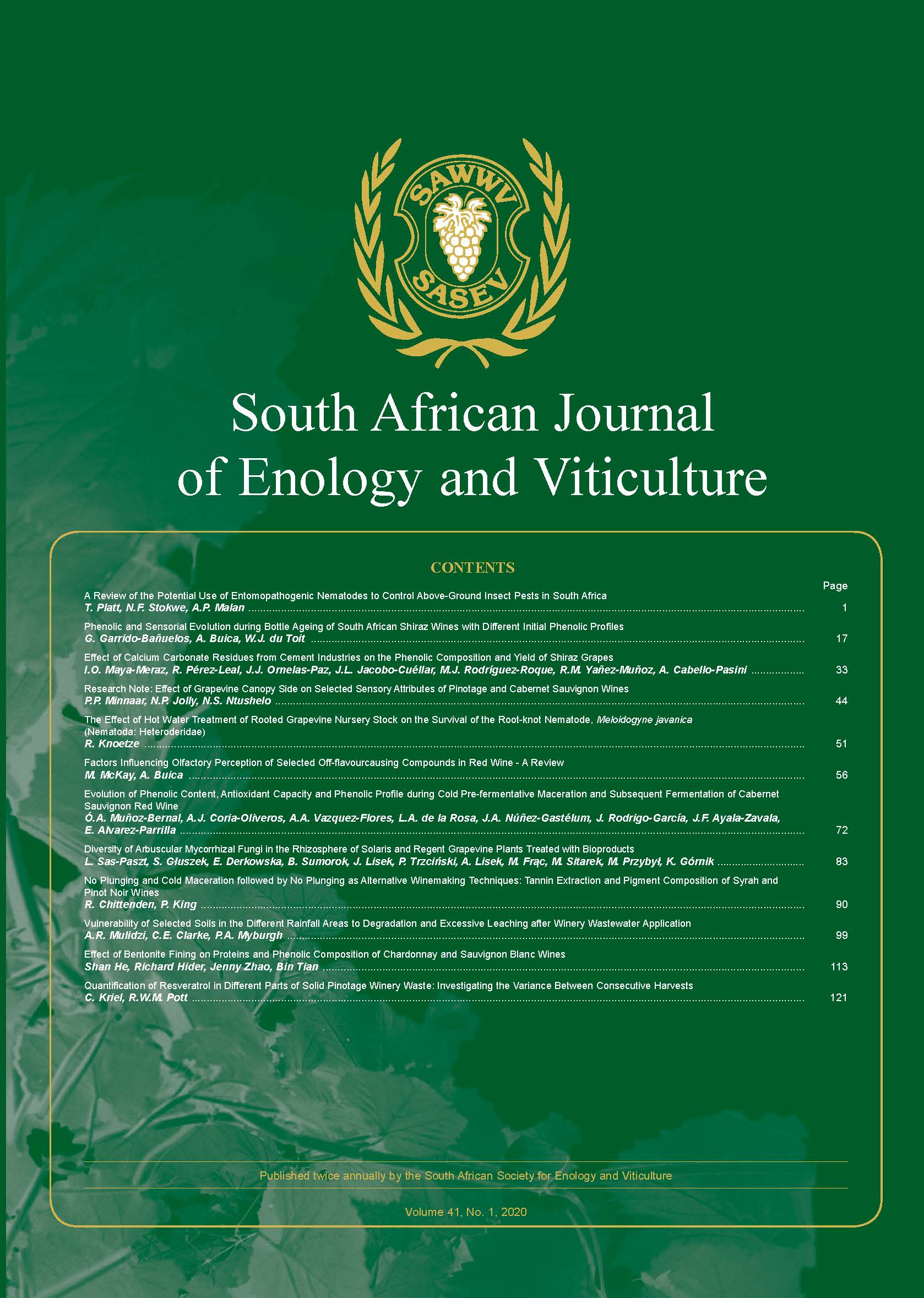Quantification of Resveratrol in Different Parts of Solid Pinotage Winery Waste: Investigating the Variance Between Consecutive Harvests
DOI:
https://doi.org/10.21548/41-1-3898Abstract
Resveratrol is phenolic compound that is produced by several plant species as a protection mechanism against biotic and abiotic stress. Resveratrol is currently being investigated as nutraceutical supplement, and there is a market value for the compound. The aim of this work was to investigate, through consecutive harvests the variability of solid winery waste as a source of resveratrol as an antioxidant supplement. In this study the different parts of Pinotage solid winery waste from a 2018 and 2019 harvests were investigated as a possible resveratrol source. From the comparison of the different sources over time it was found that the 2019 Pinotage stems contained a maximum of 73 ± 4.3 μg/g resveratrol. Variable resveratrol concentrations were noted between consecutive harvests, indicating a variability in productivity. Furthermore, resveratrol distribution throughout the plant was variable, with the canes and stems having the highest concentrations. Nonetheless, it was concluded that Pinotage solid winery waste can be used as a possible source of resveratrol. The findings in this paper provide information about the extractable resveratrol and total phenolic content of different parts of Pinotage solid winery waste and the variability of resveratrol content both within the plant, and between harvests.Downloads
References
Ainsworth, E. A. and Gillespie, K. M. (2007) ‘Estimation of total phenolic content and other oxidation substrates in plant tissues using Folin-Ciocalteu reagent’, Nature Protocols, 2(4), pp. 875–877. doi: 10.1038/nprot.2007.102.
Baur, J. A. et al. (2006) ‘Resveratrol improves health and survival of mice on a high-calorie diet’, Nature, 444(7117), pp. 337–342. doi: 10.1038/nature05354.
Devesa-Rey, R. et al. (2011) ‘Valorization of winery waste vs. the costs of not recycling’, Waste Management, 31(11), pp. 2327–2335. doi: 10.1016/j.wasman.2011.06.001.
Feijóo, O., Moreno, A. and Falqué, E. (2008) ‘Content of trans- and cis-resveratrol in Galician white and red wines’, Journal of Food Composition and Analysis, 21(8), pp. 608–613. doi: 10.1016/j.jfca.2008.06.002.
Geana, E. I. et al. (2014) ‘Characterization of Wines by Trans-Resveratrol Concentration: A Case Study of Romanian Varieties’, Analytical Letters, 47(10), pp. 1737–1746. doi: 10.1080/00032719.2014.883521.
Geana, E. I. et al. (2015) ‘Monitoring trans-resveratrol in grape berry skins during ripening and in corresponding wines by HPLC’, Food Technology and Biotechnology, 53(1), pp. 73–80. doi: 10.17113/ftb.53.01.15.3762.
Marais, J. (2003) Literature Overview Of Pinotage Research, Wine Land. Available at: https://www.wineland.co.za/literature-overview-of-pinotage-research/.
Roca, P. (2019) 2019 Statistical Report on World Vitiviniculture, International Organisation of Vien and Wine Intergovernmental Organisation. Available at: http://www.oiv.int/.
Romero-Pérez, A. I. et al. (2001) ‘Method for the quantitative extraction of resveratrol and piceid isomers in grape berry skins. Effect of powdery mildew on the stilbene content’, Journal of Agricultural and Food Chemistry, 49(1), pp. 210–215. doi: 10.1021/jf000745o.
Vincenzi, S. et al. (2013) ‘Comparative study of the resveratrol content of twenty-one italian red grape varieties’, South African Journal of Enology and Viticulture, 34(1), pp. 30–35.
World Weather Online (2019). Available at: https://www.worldweatheronline.com/stellenbosch-weather-averages/western-cape/za.aspx.
Xia, E. et al. (2013) ‘Biological Activities of Polyphenols from Grapes’, in Polyphenols in Human Health and Disease. doi: 10.1016/B978-0-12-398456-2.00005-0.
Downloads
Published
Issue
Section
License
A copyright form will be e-mailed to the corresponding author when the manuscript has been accepted for publication.
In principle, the Author agrees to the following when he/she signes the copyright agreement:
I hereby assign to the SOUTH AFRICAN SOCIETY FOR ENOLOGY AND VITICULTURE (SASEV) the copyright of the text, tables, figures, supplementary material, illustrations and other information (the Material) submitted with the manuscript to be published in SOUTH AFRICAN JOURNAL OF ENOLOGY AND VITICULTURE (SAJEV) (the "Article"). The copyright becomes effective from the date the Article has been accepted for publication in SAJEV.
This is an open access journal, and the authors and journal should be properly acknowledged, when works are cited.
Author's may use the publishers version for teaching purposes, in books, theses, dissertations, conferences and conference papers.
A copy of the authors' publishers version may also be hosted on the following websites:
- Non-commercial personal webpage or blog.
- Institutional webpage.
- Authors Institutional Repository.
The following notice should accompany such a posting on the website: This is an electronic version of an article published in SAJEV, Volume XXX, number XXX, pages XXX - XXX, DOI. Authors should also supply a hyperlink to the original paper or indicate where the original paper (www.journals.ac.za/index.php/sajev/) may be found.
Authors publishers version, affiliated with the Stellenbosch University will be automatically deposited in the University's Institutional Repository SUNScholar.
Articles as a whole, may not be re-published with another journal.
The following license applies:
Attribution CC BY-NC-ND 4.0

